Table of contents
- ABS put to the test Motorcycle anti-lock braking systems in a comparison test
- The candidates
- ABS on a dry track
- ABS with changing surfaces
- ABS on rough roads
- ABS when wet
- Test conclusion
- Guide: ABS in everyday life
- ABS works in an inclined position?
- Past and future
- ABS – what influence do the tires have?
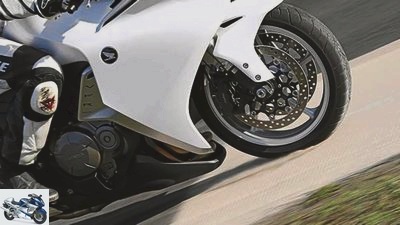
Jahn
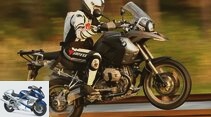
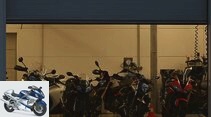
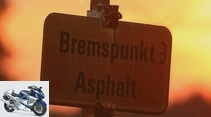
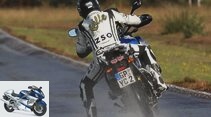
13th pictures
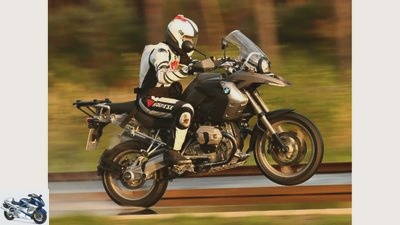
Jahn
1/13
The relations shift on the wet test track – in the truest sense of the word.
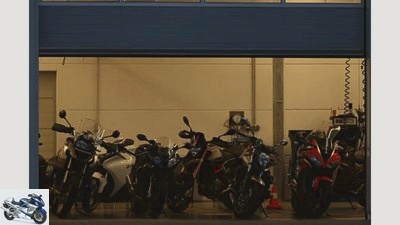
Jahn
2/13
In conclusion, it can be said that assistance systems such as ABS are now at least part of the optional basic equipment of almost all well-known manufacturers.
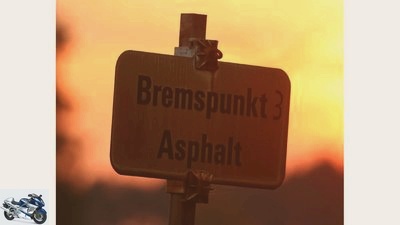
Jahn
3/13
Do you even need traction control in good road conditions??
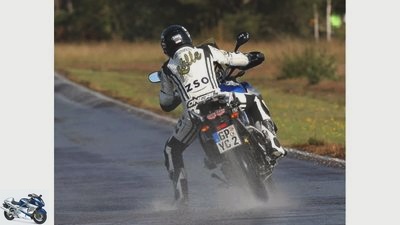
Jahn
4/13
Jump in coefficient of friction – the technical term for a suddenly changing grip on the road surface.

Jahn
5/13
The relatively simple system of the Kawasaki 1400 GTR surprises with its sensitive control behavior and cuts a good figure on the wet track.
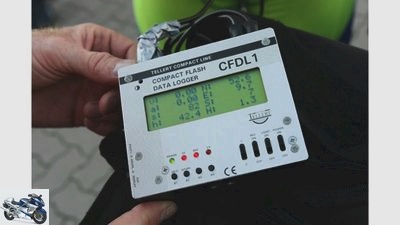
Jahn
6/13
The measured data was meticulously evaluated and compared by our team.
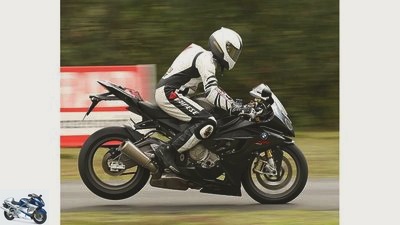
Jahn
7/13
On a dry track, the individual concepts have to prove their maximum deceleration ability.

Jahn
8/13
The sensor in the aluminum square measures the wheel speed for the slip measurement.

Jahn
9/13
Another criterion in our test was whether and how ABS works in an inclined position.
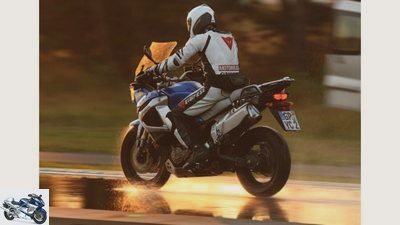
Jahn
10/13
Although the structure is relatively simple, the Yamaha Super Tenere’s solution is pleasing with sensitive intervention on wet surfaces and slippery sand fields.
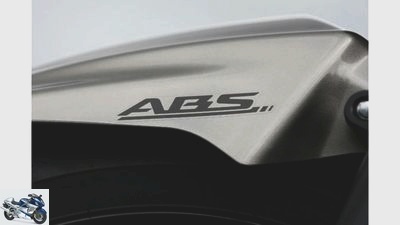
Jahn
11/13
The ten best-selling models of the past two years in Germany are now equipped with ABS.
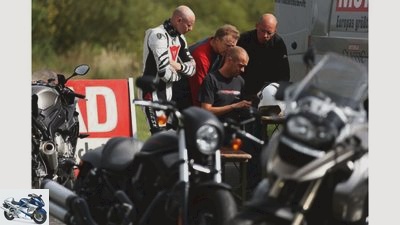
Jahn
12/13
Four different test modules, plus a demanding test set-up – this is how the individual bikes and their respective systems were tested by MOTORRAD.

Jahn
13/13
In the first traction control test of its kind, MOTORRAD scrutinized all current systems and manufacturers.
accesories
Motorcycle anti-lock braking systems in a comparison test
ABS put to the test
Motorcycle anti-lock braking systems in a comparison test
Emergency braking on roll split? No need to panic as long as electronic helpers are on board. These assistance systems can make motorcycling safer. The anti-lock braking system is of paramount importance.
Peter Mayer
10/14/2010
The ten best-selling models in Germany in the past two years are equipped with ABS. The order quota with optionally offered ABS equipment is almost 100 percent.
That is why the current ABS comparison sheds light on the entire spectrum of the motorcycle spectrum. Harley-Davidson made a name for itself as a pioneer of ABS in cruisers, which is why it represents the chopper league with the Night Rod Special. The flag of the touring faction waves the revamped one this year Kawasaki 1400 GTR, the new Yamaha Super Tenere and the evergreen BMW R 1200 GS represent the travel enduros. The sports touring segment is represented by the newly designed Honda VFR 1200 F, the classic Suzuki Bandit 1250 that of the all-rounder. The focus is on the duel between the super athletes. Finally, the Honda Fireblade was followed by the BMW S 1000 RR, which is also equipped with ABS that is suitable for the race track.
Buy complete article
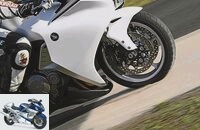
ABS put to the test
Motorcycle anti-lock braking systems in a comparison test
14 pages) as PDF
€ 2.00
Buy now
Who is missing? Unfortunately the Ducati Multistrada. After MOTORRAD’s criticism of their ABS control behavior (issue 10/2010), the Italians are currently revising the software – which is also to be updated on the Multistrada that has already been sold. MOTORRAD will take a close look at the update as soon as possible.
Not least because of the Supersport duo, MOTORRAD tightened the test conditions on the Continental test site in Jeversen near Hanover compared to the previous ABS comparisons (issues 19/2006 and 14/2009). Sand fields simulated suddenly changing subsoil, a wavy piece of asphalt simulated faults or frost breakouts. However: The results of the standard measurements on dry or wet roads do not allow any comparison with the measurements of earlier tests due to the less grippy asphalt of the Contidrom. Which does not change the fact that the results within the test field are fully comparable with one another. Whether and how ABS works in an inclined position, what influence the tires have on deceleration performance and what the future will bring in terms of ABS development.
Click here for the assistance system test – Part 2: traction control
The candidates
SUPERSPORTERS
BMW S 1000 RR
ABS manufacturer: Bosch
Brake system: partially integral
Operation of the hand lever: front / rear brake
Operation pedal: rear brake
Base price / surcharge ABS: 15500/915 euros
Honda Fireblade
ABS manufacturer: Nissin
Brake system: fully integral
Operation of the hand lever: front / rear brake
Operation pedal: brake front / rear
Base price / surcharge ABS: 14990 euros / 1000 euros
SPORTS TOURER
Honda VFR 1200 F.
ABS manufacturer: Nissin
Brake system: fully integral
Operation of the hand lever: front / rear brake
Operation pedal: brake front / rear
Base price / surcharge ABS: 14900 euros / series
TOURER
Kawasaki 1400 GTR
ABS manufacturer: Bosch
Brake system: fully integral
Operation of hand lever: front / rear brake
Operation pedal: brake front / rear
Base price / surcharge ABS: 16,995 euros / series
ALLROUNDER
Suzuki Bandit 1250
ABS manufacturer: Nissin
Brake system: front / rear separated
Operation of hand lever: front brake
Operation pedal: rear brake
Base price / surcharge ABS: 9190 euros / series
CRUISER
Harley-Davidson Night Rod Special
ABS manufacturer: Delphi
Brake system: front / rear separated
Operation of the hand lever: front brake
Operation pedal: rear brake
Base price / surcharge ABS: 18355 euros / series
TRAVEL ENDUROS
BMW R 1200 GS
ABS manufacturer: Continental
Brake system: partially integral
Operation of the hand lever: front / rear brake
Operation pedal: rear brake
Base price / surcharge ABS: 13,000 euros / 1,080 euros
Yamaha XT 1200 Z Super Tenere
ABS manufacturer: Continental
Brake system: partially integral
Operation of the hand lever: front / rear brake
Operation pedal: rear brake
Base price / surcharge ABS: 14965 euros / series
ABS on a dry track
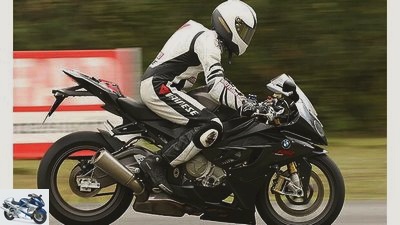
Jahn
The ABS systems of all bikes have no problem on dry roads and have very good deceleration values.
On a dry track, the individual concepts have to prove their maximum deceleration ability. A hunt for individual records.
ABS suitable for the race track. This characterization alone removes all doubts for the layman. What other machines than the two super sports cars from BMW and Honda should set the bar for the anti-lock braking system? Not even close. In addition to the control quality of the ABS, the entire vehicle concept has a decisive influence on the braking behavior of a motorcycle. After all, when braking, it is important not only to regulate the wheels as close as possible to the locking limit, but also to avoid a rollover under all circumstances. Technically, this tightrope walk is solved by a so-called plausibility query. The ABS computer uses the deceleration and the slip comparison of the two wheels to determine whether the rear wheel is lifting off and, if necessary, reduces the brake pressure. If cruisers and tourers are largely immune to the forward somersaults due to a long wheelbase and comparatively low seating positions, long-legged enduros and short athletes are latently confronted with the rollover problem due to their high center of gravity.
One of the reasons why the BMW S 1000 RR has a total of four ABS modes. While Rain, Sport and Race modes largely avoid the rear wheel lifting off, the slick set-up allows more extreme deceleration – with the risk that a rollover is possible on a non-slip or bumpy surface. Which is why all measurements of this ABS test with the BMW took place in the sport mode intended for everyday use. The Honda technicians leave it in the highly complex brake-by-wire braking system of the Fireblade with an ABS set-up that is fixed in the computer and cannot be adjusted by the pilot. In contrast to the BMW, the system cannot be switched off completely. Despite all the technical effort – in the dry braking, the wobbly sports department has to admit defeat to the majority of its colleagues with an identical 41.5 meter braking distance. Even the Enduro bowing deeply when braking Yamaha Super Tenere half a meter earlier than the super athletes, the top trio surprised even more.

Drawing: archive
The braking distance on a dry road.
With the Harley-Davidson, the Suzuki Bandit and the BMW R 1200 GS, three completely different concepts mark the best value of 39.8 meters. While the Night Rod Special comes to the rescue with the help of the rear wheel, which is effectively braking on a cruiser, the GS achieves this parade appearance with the support of a technical suspension trick. The pitch compensation of the Telelever front wheel control prevents the front from submerging when braking, thus not only reducing the tendency to rollover but also allowing a rear wheel that makes a relatively strong contribution to deceleration thanks to the reduced dynamic wheel load shift. The Suzuki received special praise for showing the braking power that can be achieved under these conditions, which are relatively uncomplicated for control, with conventional technology in the aggressively priced all-rounder segment. In contrast to the inconspicuous (Honda VFR 1200 F) or even disappointing (Kawasaki 1400 GTR) appearance of the expensive competition.
ABS with changing surfaces
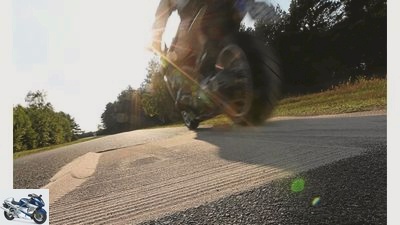
Jahn
Braking on sand is more of a problem.
A jump in the coefficient of friction – the technical term for a suddenly changing grip on the road surface – places high demands on the ABS control quality.
Change of scene. Three 1.5 meter wide sand fields, each three meters apart, lie in wait for the test machines. Pure nightmare without ABS. For the best possible deceleration, would the driver have to build up brake pressure in fractions of a second (in the specific test setup about 0.2 seconds) in the non-slip gaps and – above all – release the brake in good time before the next sand field. An impossibility. Modern ABS regulations can easily cope with what confronts human motor skills with unsolvable tasks. The diagram of a braking process with the BMW S 1000 RR on the opposite page clearly demonstrates this. After the almost unbraked passage through the sand field, recognizable by the almost identical speed of the front wheel (red line) at the beginning and end of the sand stretch, the ABS control manages to build up brake pressure in the aforementioned 0.2 seconds and the speed of the BMW within three Meters by seven (first piece of asphalt) or four km / h (second piece of asphalt).
The fact that with the Fireblade, of all things, a super sports car can do this difficult job best with a braking distance of 47 meters is extremely astonishing. After all, sports bikes like these face an acute risk of stoppage or rollover when changing the surface after the last sand field. In this case, the Honda clearly benefits from the deceleration performance, which is limited to a relatively moderate 9.3 m / s² (see results of the dry braking), and an excellent control behavior in the jumps in the coefficient of friction. A note on the side: The ABS set-up of the Fireblade used in racing differs considerably from that of the series machine. In racing, BMW is currently even completely without ABS in the S 1000 RR.
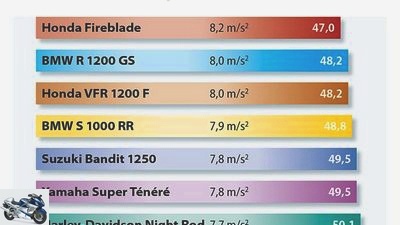
Drawing: archive
The braking distance of the bikes on sand.
Together with the BMW R 1200 GS, which is known as a reference in the touring enduro segment in terms of braking performance, the VFR 1200 F in second place. And even before the BMW S 1000 RR. Compared to the Honda Fireblade, the BMW regulates more coarsely, but grabs more acutely after the pad changes. In the end, it still needs a 1.8 meter longer braking distance compared to the Fireblade – and behaves much more nervously during braking due to the hard load changes.
While the Suzuki Bandit, which was still surprising during the dry braking, reports back with a braking distance of 49.5 meters, one would have expected more of the subjectively finely regulated Super Tenere here than just pulling on the same level as the inexpensive all-rounder. At least significantly more than the Harley ABS, which has an extremely coarse regulation on the zebra pattern, and which despite everything parks the 310-kilo truck just 60 centimeters later. The Kawasaki 1400 GTR is once again the victim of its shirt-sleeved regulation, which the driver can feel at all times. The compound braking system that was added to the range of the Tourer this year does not comfort the last place.
ABS on rough roads

Jahn
If the road quality is poor, the ABS systems show clear differences.
It never gets worse – after braking dry and jumps in the coefficient of friction, a bad corrugated iron runway finally pushes the control systems to their limits.
It is not easy to show the limits of modern anti-lock braking systems. If it succeeds, it is usually when decelerating heavily on bumpy roads. The reason: If the motorcycle rocks when braking, a rear wheel lifting on the waves can suggest a risk of rollover to the ABS software. The computer reacts with reduced brake pressure – and that may well before the wheels lock up limit. Indeed, the extremely demanding bad road stretch of the Contidrom with several up to five centimeters high asphalt wrinkles is developing into the ultimate touchstone for ABS regulations. After the dry braking and the jump in the coefficient of friction, the braking distances are by far the longest as indicators of the demands placed on the control technology.
The next surprise winner in this discipline stands out, the BMW S 1000 RR. Despite the conceptual disadvantage of a super athlete, the Bavarian literally attacks the rumble slope, fighting for every centimeter with her aggressive ABS control. The superbike comes to a standstill after 52.8 meters.
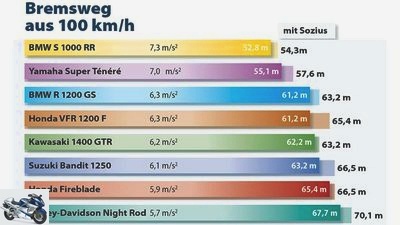
Drawing: archive
The braking distance on a bad surface.
At the same time, you can only meet the Yamaha on an equal footing, whose sensitive ABS tuning is finally bearing fruit. The rest of the field, including the BMW R 1200 GS, only follows with a respectful margin. MOTORRAD has repeatedly complained that the boxer’s ABS shows weaknesses when braking on bumpy roads. Subjectively, the GS reduces the braking power for a noticeably long time even on the rough road in the Contidrom after rough waves, but ultimately saves the overall balance through the extremely courageous intervention of the brake after the weak phase. Speaking of weakness. The Fireblade, whose ABS software obviously wants to be on the safe side in the Geholper, does this with 65.4 meters of braking distance. The formidable values of the Honda for the jump in the coefficient of friction suggest that the Nissin technicians were probably a little too keen on avoiding a rollover when applying this type of jumble slope.
ABS when wet
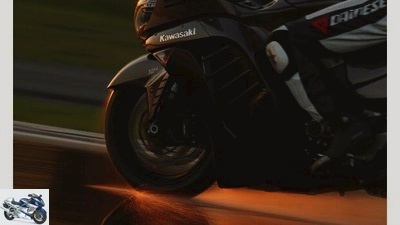
Jahn
Now it’s getting lively – with water, the ABS can show what it can do.
Emergency braking on a track that is reflecting from the wet? Without an anti-lock device, this is a reason for unwanted sweats – child’s play with ABS.
The relations shift on the wet test track – in the truest sense of the word. While most of the braking responsibility rested on the front wheel due to the dynamic wheel load shift (the rear is relieved during the deceleration, the front is loaded) in the previous measurements, the wet course changes the division of labor. Due to the lower possible maximum deceleration, significantly more weight remains on the rear wheel, which can therefore provide around 15 to 20 percent of the total deceleration power.
The integral braking systems on the two BMW and Honda models as well as the Yamaha Super Tenere have no influence on the braking distance during measurements – in which both brakes are generally used for deceleration. This would only apply if, as is often the case in everyday life, only a brake (hand lever or brake pedal) is used to decelerate.
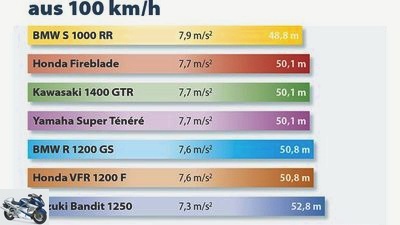
Drawing: archive
The braking distance on a wet road.
The aforementioned reduced wheel load shift on the wet track for the BMW Superbike is practically a problem that has been found. Without having to take into account the lurking risk of a rollover, the S 1000 RR with a braking distance of 48.8 meters outdoes all other concepts – and the sport colleague Fireblade on top of that. The mere fact that both the GTR and the Super Tenere stand up to the Honda proves once again the conservative set-up of the Fireblade ABS, which has been chosen with plenty of safety reserves. Especially since the more tourist-oriented BMW R 1200 GS and the Honda VFR 1200 F can hardly be distanced from it. While the Bandit only offers home cooking in the wet, the Harley can be hung once more. A braking distance of over 13 meters means that the US chopper would rush past the BMW superbike that had been braked to a standstill at 46 km / h. As little consolation, it remains that even experienced pilots with an ABS-free cruiser would hardly achieve better values on this critical surface.
Test conclusion
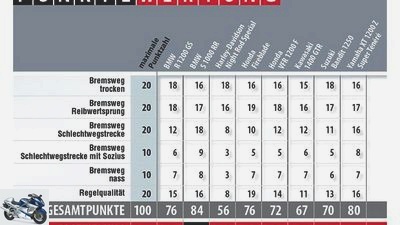
Drawing: archive
The final score.
The fact that there are two top runners from the current model year with the BMW S 1000 RR and the Super Tenere confirms that ABS is also developing further.
Four different test modules, plus a much more demanding test set-up in the criteria of a jump in the coefficient of friction and a rough road surface – the ABS comparison of the 2010 MOTORRAD year raised the bar even higher. That even the overall winner, the BMW S 1000 RR, in addition to two brilliant performances (bad road and wet) in the two other criteria has to be content with the deceleration level of travel enduro and all-rounders and ultimately not a single concept can end up consistently in the front field in all disciplines, proves One thing in particular: The coordination of the ABS control technology in the motorcycle remains an extremely complicated matter.
Click here for the assistance system test – Part 2: traction control
Guide: ABS in everyday life
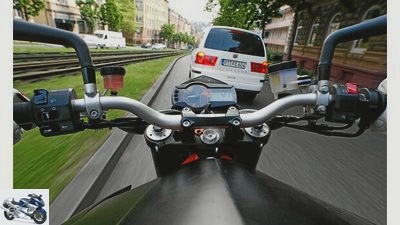
jkuenstle.de
The ABS also proves itself in everyday life?
ABS on board – and everything will be fine? Not quite true. MOTORRAD clarifies how the blockage protection works on lean angles and with old tires, explains the braking process and looks into the future of ABS technology.
Fritz Frohlich enjoys the mild autumn day, swinging his new Yamaha Super Tenere with relish from curve to curve. He feels safe, after all, the 1200 has ABS. And so, he has read, he brings his pedestal to a safe standstill in just under 41 meters at country road speed. It is understandable that the deer tripping from the forest path about 50 meters away leaves him cold. With presence of mind, he climbs into the iron – and whistles by the astonished red deer by a hair’s breadth. Carefree Fritz’s knees are shaking. Because the Yamaha rider forgot something: braking distance does not mean stopping distance.
While in an ABS comparison the difference between the shortest and longest braking distance in a category shrinks to up to three meters, people still play an important role.
To come back to Fritz swinging at 100 km / h: It generally takes 0.1 seconds for the motorcyclist to recognize the deer as a danger, another 0.8 seconds for hand and foot to apply the brakes. In this moment of shock, Fritzchen rolls around 25 meters – unrestrained. For this he now squeezes powerfully. The hand lever with about 140 Nm (about 14 kilograms), the pedal with about 30 kilograms. It takes another 0.2 seconds for the pressure in the brake lines to rise to around 20 bar (front) and 28 bar (rear) and the brake pads are flush against the discs. Another 5.6 meters of braking distance are wasted.
Finally the time has come. After 30 meters the stoppers bite shut. If exactly half of the 267 kilograms of the XTZ are on the two wheels when the vehicle is stationary, the weight is shifted almost completely to the front wheel due to the inertia during extreme deceleration. In this case, the expert speaks of a dynamic wheel load shift. A force that forces the upside-down fork to its knees by a good two thirds of its 190 millimeter spring travel. At this moment, the enormous contact pressure squeezes the tire contact area by about 30 cm² to three times.
If our Fritz remains on the brakes undiminished, the work of the ABS begins. The system receives the most important information for this from sensors, which measure the speed of the front and rear wheels via a perforated disk on the hub. By comparing them, the ABS computer recognizes a blocked condition of the wheels and instructs the pressure modulator to reduce the brake pressure via a valve. As soon as the wheels start moving again, the brake pressure increases and the game starts all over again. For maximum deceleration, the ABS control allows the wheels to turn at 90 percent of the vehicle speed when dry (ten percent slip) or when it is wet at 75 percent of the vehicle speed (25 percent slip). Three seconds later the Yamaha is standing – after a total of 71.6 meters. Fritz was lucky. The deer too.
ABS works in an inclined position?
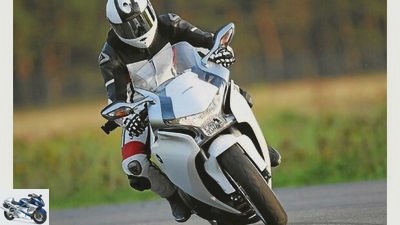
Jahn
Where raw forces prevail: only the firmly gripping braking hand and the rolling tire flank betray the emergency braking in an inclined position.
Does an anti-lock braking system also regulate in an inclined position? Or to put it another way: Can you step fully into the irons even when you are on an incline? MOTORRAD tried it out.
The uncertainty among motorcyclists is still great. Can ABS prevent the wheels from locking even when the vehicle is leaning? So make it possible to apply the brakes with full force, even when cornering, without immediately lying on your nose? Doubts are in order. A queasy feeling to try this out, especially. The experimental setup should minimize the risks as much as possible. The Honda VFR 1200 F circles at a constant 50 km / h on an extensive circular path. Head tester Karsten Schwers selects the radius according to the incline indicator mounted on the tank, and should brake with full force at 30 and 35 degrees incline. For orientation: On the country road, an incline of 40 degrees is the acceptable maximum. And another reference value: when you fully brake from 50 km / h while driving straight ahead, the VFR stops after 10.4 meters.
Helmet on. After two laps, colleague Schwers leveled the Honda down to a 30 degree incline – and got into the iron. What is happening? The machine stands up in a flash and comes to a stop after a sensational 10.6 meters. Next attempt at 35 degrees incline. Full braking again, the VFR stops after 12.7 meters. A value that corresponds to the braking distance in wet conditions.
Much more important, however, is that during these emergency stops, neither the front nor the rear wheel tended to lock, so there was never any risk of falling. Which means nothing else than that modern ABS systems are perfectly suitable for inclining up to a certain limit. But be careful: firstly, the maximum transferable braking force decreases disproportionately after the 35-degree mark, and secondly, the vehicle is forced into a larger curve radius by the momentum when braking.
Past and future
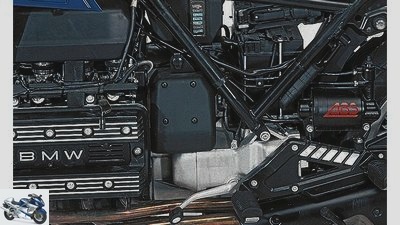
archive
History: In 1988, the first production ABS weighed eleven kilograms.
It has been over two decades since BMW offered the first anti-lock braking system in series motorcycle production in the K 100 models in 1988. Despite eleven kilograms more weight and 1,800 marks surcharge, this pioneering act heralded the triumph of ABS. The impressive further development of ABS technology is reflected, in addition to the enormous increase in computer performance, above all in the reduced size of the components. The ABS in the BMW S 1000 RR now weighs just 2.5 kilograms, and the pressure modulator, the mechanical heart of an anti-lock braking system, weighs just 700 grams, but the cornerstone for the next phase of development has already been laid. Microtechnically manufactured gyro sensors will be able to exactly recognize the driving condition of the motorcycle and adapt the ABS control accordingly. The long-awaited goal could thus become a reality: ABS that is fully suitable for lean angles.
ABS – what influence do the tires have?
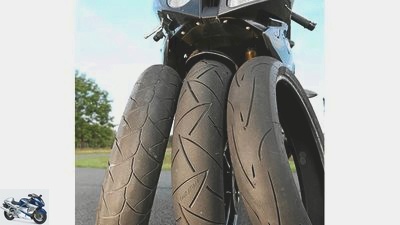
archive
Three tires, two braking distances – and one insight.
Does the choice of tires influence the braking behavior with ABS? MOTORRAD put it to the test – with a sports, a touring and an eight-year-old all-round tire.
The choice of tires – in motorcycle circles it is always an important topic. It is just strange that tires hardly play a role in discussions about the subject of ABS. After all, a sporty, grippy tire could allow a shorter braking distance than a hard touring tire.
But does this also apply to use with ABS? MOTORRAD put it to the test and delayed the BMW S 1000 RR (ABS in sport mode) on three different front tires: the super sporty Conti Race Attack, the touring sport tire Conti Road Attack and – as a contrast – an eight-year-old copy of the all-rounder Bridgestone BT 019.
The result: No measurable differences between the sports and touring tires, which achieved the same braking distance of 41.5 meters as the original BMW (Metzeler Racetec K3). The worn-out oldie, on the other hand, clearly had to give up at 44.9 meters. Interesting: The same picture emerged in the extended test in the more aggressively tuned slick mode. The two racing and touring tires again achieved the same braking distance at 39.6 meters, the difference to the aged tire was once again a good three meters (42.9 meters).
| Tire comparison S 1000 RR (sport mode) | delay | Braking distance |
| Conti Race Attack | 9.3 m / s² | 41.5 m | Conti Road Attack | 9.3 m / s² | 41.5 m |
| older all-round tires | 8.6 m / ² | 44.9 m |
Related articles
-
Defects in anti-lock braking systems
BMW motorcycles Defects in anti-lock braking systems Defects in anti-lock braking systems Failure symptoms ABS is the most important, oldest and most…
-
4 lean ABS systems in the endurance test
4 lean ABS systems in the endurance test Lean ABS systems put to the test 4 current curve anti-lock braking systems in comparison Full in the irons with…
-
Assistance systems: traction control in the test
Jahn 13th pictures Jahn 1/13 The relations shift on the wet test track – in the truest sense of the word. Jahn 2/13 In conclusion, it can be said that…
-
Comparison test: Honda Hornet, Kawasaki Z 750, Suzuki GSR 600
Jahn motorcycles Comparison test: Honda Hornet, Kawasaki Z 750, Suzuki GSR 600 Comparison test: Honda Hornet, Kawasaki Z 750, Suzuki GSR 600 ABS shooters…
-
Comparison test Ducati Monster 1200 S, Honda Fireblade, Kawasaki Z 1000 SX, Suzuki GSX-S 1000 F
jkuenstle.de 27 pictures jkuenstle.de 1/27 The disguised Suzuki GSX-S 1000 F has to prove itself in the field of competitors. jkuenstle.de 2/27 Nice is…
-
Braking properly with the motorcycle
Jahn counselor Driving experience & Driving tips Braking properly with the motorcycle Brake properly Braking with and without ABS Motorcycles ride well…
-
Motorcycle touring tires 120-70 ZR 17 and 180-55 ZR 17 in the test
Jahn 30th pictures Jahn 1/30 mps photo studio 2/30 Metzeler Roadtec Z8 Interact: MOTORRAD verdict: 6th place, 212 points. mps photo studio 3/30 Michelin…
-
Comparison test BMW K 1300 R, Buell 1125 CR, Suzuki B-King, Yamaha Vmax
K 37 pictures Yamaha 1/37 First look at the device from all sides… Yamaha 2/37 Yamaha 3/37 Yamaha 4/37 Yamaha 5/37 Yamaha 6/37 Yamaha 7/37 What is…
-
Honda NC 700 S in the test: the entry-level motorcycle from Honda
Artist 12th pictures Honda 1/12 Honda NC 700 S – The naked bike is powered by an in-line two-cylinder engine of 670 cubic meters. Honda 2/12 Honda NC 700…
-
MOTORCYCLE comparison test Alpen-Masters 2014 part 2
jkuenstle.de 116 pictures fact, jkuenstle.de 1/116 The extreme seating position was also not ideal for the test track. fact, jkuenstle.de 2/116 However,…